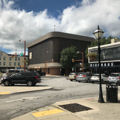The markets were removed from the square in 1872 and replaced by a central fountain in a landscaped circle. In 1904, the fountain was relocated to a city park and replaced by a bronze statue of a mounted Civil War soldier, known as the “Picket,” commemorating the battle of Hanover that was part of the Gettysburg campaign. With the reconfiguration of the square to better handle traffic, the statue was moved to the north corner in the vicinity of a handsome cast-iron-fronted commercial building. Images of the town square from before World War II show a rich mixture of eighteenth-, nineteenth-, and early-twentieth-century buildings that gave coherence to the space. The present mixture of large-scale modern claddings and low commercial buildings is visually incoherent.
You are here
Fountain Square
If SAH Archipedia has been useful to you, please consider supporting it.
SAH Archipedia tells the story of the United States through its buildings, landscapes, and cities. This freely available resource empowers the public with authoritative knowledge that deepens their understanding and appreciation of the built environment. But the Society of Architectural Historians, which created SAH Archipedia with University of Virginia Press, needs your support to maintain the high-caliber research, writing, photography, cartography, editing, design, and programming that make SAH Archipedia a trusted online resource available to all who value the history of place, heritage tourism, and learning.









